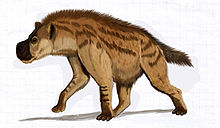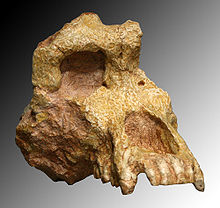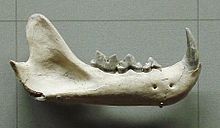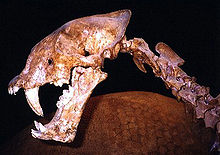- Miomachairodus
-
Miomachairodus
Temporal range: Middle Miocene–Late MioceneConservation status FossilScientific classification Kingdom: Animalia Phylum: Chordata Class: Mammalia Order: Carnivora Family: Felidae Subfamily: Machairodontinae Tribe: Machairodontini Genus: Miomachairodus Species Miomachairodus pseudaeluroides
Miomachairodus was an extinct genus of large saber-toothed cats of the subfamily Machairodontinae, that lived in Europe, Asia, Africa, and North America during most of the Miocene. It survived until the Late Miocene (early Vallesian).
Miomachairodus coexisted with the barbourofelid Barbourofelis in its North American range.
Contents
Fossil record
The only adequate collection of Miomachairodus fossils is the Vallesian-age Bahe Formation in Shaanxi, China.
A second locality for the discovery of Miomachairodus fossils is Anatolia, Yeni Eskihisar. This Turkish site is of Miocene age and is well known for its pollen studies.
Though none of their fossil beds have provided Miomachairodus, the region of Greece during the middle Miocene is close to Turkey and displays a similar habitat. Aliveri (Evia island) in Greece shows a rich micromammalian fauna but with few large mammals. The island of Chios is known for its middle Miocene faunas from the beginning of 1940s when the first large mammals have been described from a clay pit near Thymiana village. Of the two Vallesian periods (early, or MN9, and late, or MN10) only the late is represented by the formations of Greece.
Morphology
Miomachairodus was generally small and the canines already began to show the flattening that would soon advance into the distinct "sabre-tooth" design of the more advanced machairodonts. Miomachairodus was not the ancestor to all machairodonts, this title most likely rested with Pseudaelurus. This genus is thought to be ancestral to both machairodontinae and felini, the clades of sabre-toothed and conicle-toothed (modern) felids.
Comparison to Relatives
the knobby skull of Homotherium, distinctly Homotheriini, resembling Machairodus but with shorter canines and a mandible that is more stout.
Sister taxa of Miomachairodus is the more well known Machairodus. Of the several species of widespread Machairodus, M. giganteus is probably the most well known. The fossil reccord is well established in its wide range of Eurasia. Most mammals, even the largest, started out small, and Machairodus is no exception. Pseudaelurus ogygia stood at 58 cm at the shoulder[1] and its ancestor Miomachairodus advances little in size, but between Miomachairodus and the it's descandants of the tribe Homotheriini (one of three machairodont tribes; including Machairodus and Homotherium), they grow to massive sizes, surpassing the modern lion. Most Machairodus species reach 120 cm shoulder height and Homotherium reaches 110 cm, when compared to the 95 cm shoulder height of the modern bengal tiger, Panthera tigris. Machairodus rivals in size among the cats only Smilodon populator of South American Pleistocene.
The older Pseudaelurus is long-backed and appears lanky. It was arborial and spent a great deal of time climbing. Its long tail was adapted for balancing and it was probably not a successful runner, relying on ambush styles rather than long prusuits. It was a forest dweller that was most likely nocturnal or crepuscular and preyed on birds, small mammals, eggs, and, on the rare occasion, fruits, beetles, insects, or scavenged meals as some modern felids will. Pseudaelurus was not a strict carnivore as later descdants would be, but relied more on a carnivorous diet with some glimpses into an omnivorous past.
The later Machairodus was a massive creature with a tail of medium length that did not reach the ground while standing, large ribcage, stout body, and especially strong forequarters. Its skull was long, canines of moderate length for a machairodont, making it a very good representative of the group. Sexual dimorphisim displayed itself in males that were much larger and, unusual for carnivores, the main killing apparatus, the canines, were shaped differently and were surely not capable of exactly the same method of killing. Male canines were shorter and much more stout, while females were long and thin. The question of the specific usage of the canines is still in limbo, and Machairodus offers a good deal of suggestion as to how they were used, giving support to the usually inadequate claim that they were used for show, not for killing, though the hypothsis is still generally discarded. Machairodus was also in the leagues of the extreme carnivores, or hypercarnivores who could consume little but meat, and generally fresh meat at that, so scavenging was usually out of the range of means of sustinance. Modern species displaying themselves as hypercarnivores are Acinonyx jubatus, the cheetah, and Ursus maritimus, the polar bear. It has been thought that Machairodus hunted in groups, along with Homotherium, who are strangly linked to Mammoth juvenile remains, so whether these machairodonts preyed strictly on mammoth young or scavenged or whether the links are unrelated is uncertain.
Miomachairodus lied between these two, but since their fossil history is wildly incomplete, inferences must be made as to where between these two Miomachairodus lied.
 depiction of Hipparion the equid
depiction of Hipparion the equid
Ecology
Bahe Formation
Species that Miomachairodus would probably have encountered in this region of China would have certainly been reptiles such as Emydidae and Testudo. Both are turtles and Miomachairodus was not suited for killing them in any way. Only species with exceptionally strong jaw bites, such as the modern Crocuta, the spotted hyena of Africa, could have torn open the shell to retrieve the meat on the inside. These species would have been left alone. Another unwelcoming creature would have been Erinaceus. Members of this genus still live today, and we generally call them hedgehogs. Most species can but will not eat them for risk of injury caused by the spines, which are, as with porcupines, modified hair, but nevertheless painful and possibly opening the animal up to infection from an open sore. The rhinocerid Dicerorhinus was also located in this region at this time. Members of this species still exist, though may not for much longer: the remaining member is the critically endangered Sumatran Rhinoceros, or Asian one-horned Rhino as it's technically called. During the Miocene, this genus was likely to be small, but probably still too much of a feat for a lone Miomachairodus, though if it worked in groups as its descendants showed, it might have been able to take the young or the injured. Hipparion was probably prime prey for Miomachairodus at this locality. It was small and light-footed, and though the morphology of Miomachairodus suggests it did not partake on long chases, it probably used the cover of trees, foliage, and shadows during dusk and at night to creep up on herds of Hipparion and capture one in the short struggle that is typical of felines. The suid Chleuastochoerus was again probably another very good candidate for prey of Miomachairodus. Even modern pigs are primitive in form, and Miocene Cheleuastochoerus looked much like the modern pigs we consume in the modern world in their low forms, two toes per foot, and lack of extreme defense besides tusks that can kill if the predator is too inexperienced or lame to subdue the animal quickly. The giraffid Paleotragus looked much like the modern okapi, Okapia johnstoni. Paleotragus was a common prey for many predators of the Miocene, and its descendant lineage which became the Okapia did not change much and as felines took to the adaptive radiation of later eras, the lineage became common prey for felines living in the region it inhabited. During the Miocene, there were two species of Paleotragus: P. primaevus, who had no ossicones and was smaller, at just under two meters at the shoulder, and P. germaini who bore the ossicones later giraffe and okapie males would bear. Miomachairodus might have been too small to take on Paleotragus alone, but if they acquired the adaptation of grouping, it was likely that this animal, too, fell on their list of prey.
Yeni Eckihisar
The other predators noted here, including the large hyaenids Thalassictis and Proticititherium,[2] probably meant that here, Miomachairodus was increasingly nocturnal to adoid its duirnal relatives. The fauna was likely widely different, and behavioral aspects might have been noted. Solitary lives could be inferenced because smaller prey must have been taken, and as smaller prey was taken, each individual needed more land to support itself and the population was likely more spread out than it was in the Bahe region. It probably preyed more on amphibians and small reptiles, along with small rodents and birds, not often taking the larger fauna that would have been seen in the Bahe regions.
 Dinocrocuta of the Greek localities.
Dinocrocuta of the Greek localities.
 Ouranopithecus of the Greek localities.
Ouranopithecus of the Greek localities.
Greece
Again, though this region never produced Miomachairodus fossils, it is in close proximity with those fossil beds in Turkey that did, so for the purposes of comparison when good fossil records are absent, inference of similar ecosystems and species to some degree may be taken. The fossil beds in Greece during the middle and late Miocene uncovered more hyaenids, such as the large Dinocrocuta[3] who probably would have forced Miomachairodus, if it existed in this region, back into a nighttime hunting style and avoidance of direct competition. Here, the Miocene primate Mesopithecus of the family Cercopithecidae, or the old world monkeys, of which there are pleanty of members alive today, from Papio, the baboon, to Semnopithecus including langurs. These primates would have been ideal for hunting of this semi-arborial forest machairodont, and whether alone or in groups, hiding from Dinocrocuta or dealing well with the large carnivore and playing a more active role as a dominate predator in the ecosystem, it would be likely that Miomachairodus would have hunted Mesopithecus. The rhinocerid Dicerorhinus (who's local fossils might mistakenly been identified, actually being the first appearance of Brachypotherium in Europe) was probably not a good candidate for the lone Miomachairodus, although good prey for Dinocrocuta. The small rodent Pogonomys was present in this region and would likely have been small prey for Miomachairodus. The early hominid Ouranopithecus appeared briefly in this region during the late Miocene and could have been prey for Miomachairodus and Dinocrocuta.
Lifestyle
Since the fossil reccord is so scarce for this species, it's hard to tell exactly what this animal would have acted like or how it might have hunted. With species like Smilodon fatalis, it's relatively easy to at least make hypothesis about social life, to infer that the presence of terrible injuries that healed indicated hunting large animals and a strong social structire that cared for the wounded. Species like the large and lean Acinonyx pardinensis can be compared with great accuracy to the modern cheetah, Acinonyx jubatus and their hunting styles and social behavior were probably very much alike. With this old species that had no particularly good fossils or modern descendants, the infernences on its life are at best guesses based on the gueses of more well known extinct relatives such as the Homotheriini tribe.
Behavior
As a felid, it probably experienced some degree of sexual dimorphism, most likely with the males being larger. It would have been territorial and might have sprayed it range with urine like modern cats, telling the marker's age, gender, and if it's a female, estrus cycle. Fighting would have been limited, but unlike many other animals, there would probably have been no elaborate fighting ritual: a fight would consist of blood actually being drawn and injuries that, if one was ganged up on as seen in the modern lion, could be fatal. But these fights, for that reason, would be scarce and would probably be concerned with territorial disputes and mating rights. Biting with the incisors could have been suitable, but the canines were growing more fragile, and a rough jerk from the opponent while being bitten could break a canine off completely, as seen with Smilodon and Machairodus, so this was a risk probably not taken. Vocalizations would have been limited, and the main form of communicating would have been scent left in markers, and possibly visual if two came into contact. Motions of the tail and ears alnog with general body positioning would have been utilized for these purposes.
Breeding
Most feline species have young in a select period of time if the seasons are defined enough, but if this animal lived in a warm, forested environment when food was available year round, it might have had offspring at any time in the year. Modern feline cubs of the larger species, specifically Panthera are kicked out between one and two years of age, but there is recent evediance that long teeth that the machairodonts were known for took longer to develop and species such as Barbourofelis (a Barbourofelid, not feline, as it is common mistaken), Smilodon, and especially Machairodus, and cubs might have had to stay with their mothers until three, possibly even four years of age, depending on the individual mother's tolerance or readiness to mate again. Numerous Machairodus skulls are found with mature canines still erupting, and until then, they would be inable to hunt for themselves. If the start of long sabres for Miomachairodus meant a longer time until cubs were independent, they might be staying with their mothers for a full year longer than modern cats.
Hunting
The specialization of the dentition of Miomachairodus would have meant a limited number of prey items. Fewer teeth that were primarily slicing premolars and not crushing molars meant that grass or anything with cellulose would not have been on the menu. The specialization of diet, from omnivore eating mostly meat, to obligatory carnivore eating almost nothing but meat, takes its toll on an individual. Certian machairodont groups crossed the boundary from normal obligatory carnivore, including all of today's cats, to the category of hypercarnivore. This group consists of a handful of the species most dependent on meat, from cheetahs, Acinonyx jubatus, who will eat only fresh kills that they have killed themselves through their unique hunting sequence, to polar bears, Ursus maritimus who eat only seals in the Arctic where most of the year there is no plant material to be eaten. Machairodonts such as the Homotheriini group are placed in this league because their dentition denies them eating nothing but meat, and probably fresh, so scavenging is unlikely for Miomachairodus.
This increasing dependency on meat meant that hunting would occupy more time and an any injury could have led to an inability to hunt and starvation, so the species would have to be careful of such risks. This could be combated, on the other hand, if the species was social, as in Smilodon. Risks would still be risks, but if an animal sprained a wrist, it could still fall back on family members as seen in wolves and occasionally lions in the modern day. Lion prides consist of related females and an unrelated male (or several if they are brothers or cousins) who take over the pride and are periodically kicked out by a new male(s). This might have been the way a Miomachairodus familial group functioned.
References
- ^ Turner, Alan (1997). Big Cats and their Fossil Relatives. Columbia Press.
- ^ Fortelius, Mikael. Geology and paleontology of the Miocene Sinap Formation, Turkey.
- ^ G.D. Koufos. "The Neogene mammal localities of Greece:". http://www.hellenjgeosci.geol.uoa.gr/41/koufos.pdf.
- Jordi Augusti: Mammoths, Sabertooths and Hominids 65 Million Years of Mammalian Evolution in Europe, Columbia University Press, 2002. ISBN 0-231-11640-3
- Lars W. van den Hoek Ostende, Michael Morlo & Doris Nagel (July 2006). "Fossils explained 52 Majestic killers: the sabre-toothed cats". Geology Today 22 (4): 150. doi:10.1111/j.1365-2451.2006.00572.x.
- ^ Turner, Alan (1997). Big Cats and their Fossil Relatives. Columbia Press.
- ^ Fortelius, Mikael. Geology and paleontology of the Miocene Sinap Formation, Turkey.
- ^ G.D. Koufos. "The Neogene mammal localities of Greece:". http://www.hellenjgeosci.geol.uoa.gr/41/koufos.pdf.
Categories:- Saber-toothed cats
- Miocene mammals
- Pliocene mammals
Wikimedia Foundation. 2010.







